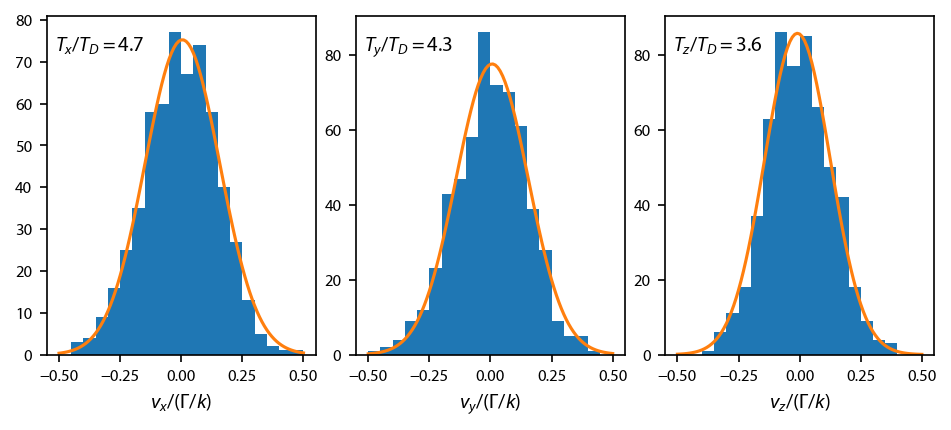\(F=0\rightarrow F=1\) MOT temperature with the OBE¶
This example covers single atom evolution in a 3D MOT with no gravity using the optical Bloch equations. It highlights an interesting effect of the 3D lattice that is inherent in all MOTs.
[1]:
import numpy as np
import matplotlib.pyplot as plt
import pylcp
import lmfit
from pylcp.common import progressBar
Define the problem¶
Laser beams, magnetic field, and Hamiltonian.
[2]:
laser_det = 0
det = -2.5
s = 1.25
transform = True
laserBeams = pylcp.conventional3DMOTBeams(
s=s, delta=0., beam_type=pylcp.infinitePlaneWaveBeam
)
#laserBeams.beam_vector[2:7] = [] # Delete the y,z beams
#laserBeams.num_of_beams = 2
alpha = 1e-4
magField = pylcp.quadrupoleMagneticField(alpha)
# Hamiltonian for F=0->F=1
H_g, muq_g = pylcp.hamiltonians.singleF(F=0, gF=0, muB=1)
H_e, muq_e = pylcp.hamiltonians.singleF(F=1, gF=1, muB=1)
d_q = pylcp.hamiltonians.dqij_two_bare_hyperfine(0, 1)
hamiltonian = pylcp.hamiltonian(H_g, -det*np.eye(3)+H_e, muq_g, muq_e, d_q, mass=100)
obe = pylcp.obe(laserBeams, magField, hamiltonian,
transform_into_re_im=transform)
Calculate the equilibrium force¶
Let’s try looking at a single force profile along each axis, \(\hat{x}\), \(\hat{y}\), and \(\hat{z}\):
[3]:
z = np.arange(-5.01, 5.01, 0.25)
R = {}
R['x'] = [2*z/alpha, np.zeros(z.shape), np.zeros(z.shape)]
R['y'] = [np.zeros(z.shape), 2*z/alpha, np.zeros(z.shape)]
R['z'] = [np.zeros(z.shape), np.zeros(z.shape), z/alpha]
V = {
'x':[0.0*np.ones(z.shape), np.zeros(z.shape), np.zeros(z.shape)],
'y':[np.zeros(z.shape), 0.0*np.ones(z.shape), np.zeros(z.shape)],
'z':[np.zeros(z.shape), np.zeros(z.shape), 0.0*np.ones(z.shape)]
}
for key in R:
obe.generate_force_profile(
R[key], V[key],
name=key, deltat_tmax=2*np.pi*100, deltat_r=4/alpha,
itermax=1000, progress_bar=True
)
Completed in 10.03 s.
Completed in 9.11 s.
Completed in 10.50 s.
Plot it up:
[4]:
fig, ax = plt.subplots(1, 1)
for ii, key in enumerate(obe.profile):
ax.plot(z, obe.profile[key].F[ii])
ax.set_xlabel('$x/(\mu_B B\'/\hbar \Gamma)$')
ax.set_ylabel('$f/(\hbar k \Gamma)$');
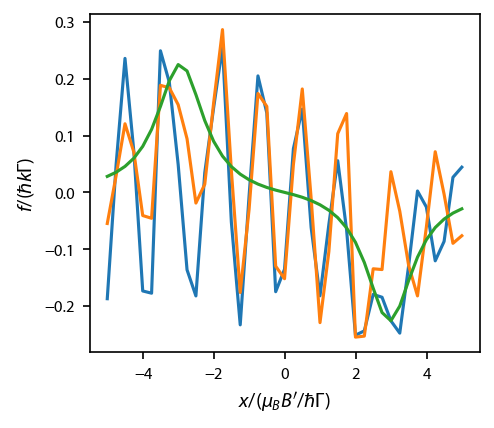
Obviously there is something going on with the \(\hat{x}\) and \(\hat{y}\) directions. The thing that is going on is interference in the optical lattice created by the 6 beams, and it is pronounced because the atom is not moving. Let’s repeat this exercise, but average over a period of the laser lattice.
Average over the lattice¶
Again, note the the \(x\) and \(y\) calculation is a factor of 2 larger than \(z\).
[5]:
z = np.arange(-5.01, 5.01, 0.25)
R = {}
R['x'] = [2*z/alpha, np.zeros(z.shape), np.zeros(z.shape)]
R['y'] = [np.zeros(z.shape), 2*z/alpha, np.zeros(z.shape)]
R['z'] = [np.zeros(z.shape), np.zeros(z.shape), z/alpha]
V = {
'x':[0.0*np.ones(z.shape), np.zeros(z.shape), np.zeros(z.shape)],
'y':[np.zeros(z.shape), 0.0*np.ones(z.shape), np.zeros(z.shape)],
'z':[np.zeros(z.shape), np.zeros(z.shape), 0.0*np.ones(z.shape)]
}
Npts = 128
for key in R:
progress = progressBar()
for ii in range(Npts):
obe.generate_force_profile(
R[key] + 2*np.pi*(np.random.rand(3)-0.5).reshape(3,1), V[key],
name=key + '_%d'%ii, deltat_tmax=2*np.pi*100, deltat_r=4/alpha,
itermax=1000, progress_bar=False
)
progress.update((ii+1)/Npts)
Completed in 23:25.
Completed in 41:04.
Completed in 35:21.
Now take the average:
[6]:
avgF = {}
for coord_key in R:
avgF[coord_key] = np.sum([obe.profile[key].F for key in obe.profile if coord_key in key], axis=0)/Npts
Now plot it up:
[7]:
fig, ax = plt.subplots(1, 1)
for ii, key in enumerate(R):
ax.plot(z, avgF[key][ii])
ax.set_xlabel('$x/(\mu_B B\'/\hbar \Gamma)$')
ax.set_ylabel('$f/(\hbar k \Gamma)$');
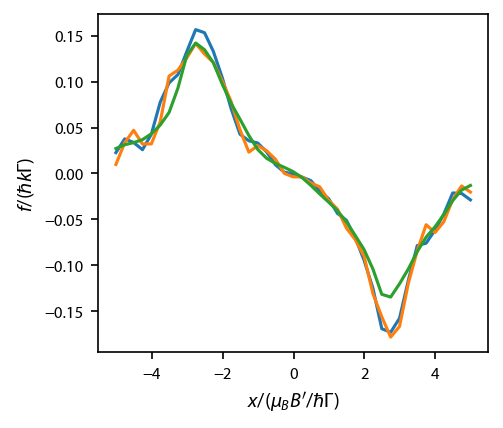
That looks much better.
Evolution without random scattering¶
One can choose various initial states. Sometimes we appear to get trapped in some lattice if we choose our initial state poorly.
[22]:
# %% Now try to evolve some initial state!
obe.v0 = np.array([0., 0., 0.])
obe.r0 = np.random.randn(3)/alpha
#obe.r0 = np.array([0., 100., 0.])
#obe.r0 = np.array([0., 0., 10.])
obe.set_initial_rho_from_rateeq()
# obe.set_initial_rho_equally()
t_span = [0, 1e4]
obe.evolve_motion(t_span,
progress_bar=True,
random_recoil=False
);
Completed in 1:00.
Plot it up:
[23]:
fig, ax = plt.subplots(1, 2, num='Optical Molasses F=0->F1', figsize=(6.5, 2.75))
ax[0].plot(obe.sol.t/1e3, obe.sol.r[0]/1e3,
label='rx', linewidth=0.5)
ax[0].plot(obe.sol.t/1e3, obe.sol.r[1]/1e3,
label='ry', linewidth=0.5)
ax[0].plot(obe.sol.t/1e3, obe.sol.r[2]/1e3,
label='rz', linewidth=0.5)
ax[0].legend(fontsize=6)
ax[0].set_xlabel('$10^3 \Gamma t$')
ax[0].set_ylabel('$10^3 kr$')
ax[1].plot(obe.sol.t/1e3, obe.sol.v[0],
label='vx', linewidth=0.5)
ax[1].plot(obe.sol.t/1e3, obe.sol.v[1],
label='vy', linewidth=0.5)
ax[1].plot(obe.sol.t/1e3, obe.sol.v[2],
label='vz', linewidth=0.5)
ax[1].legend(fontsize=6)
ax[1].set_xlabel('$10^3 \Gamma t$')
ax[1].set_ylabel('$v/(\Gamma/k)$')
fig.subplots_adjust(wspace=0.25)
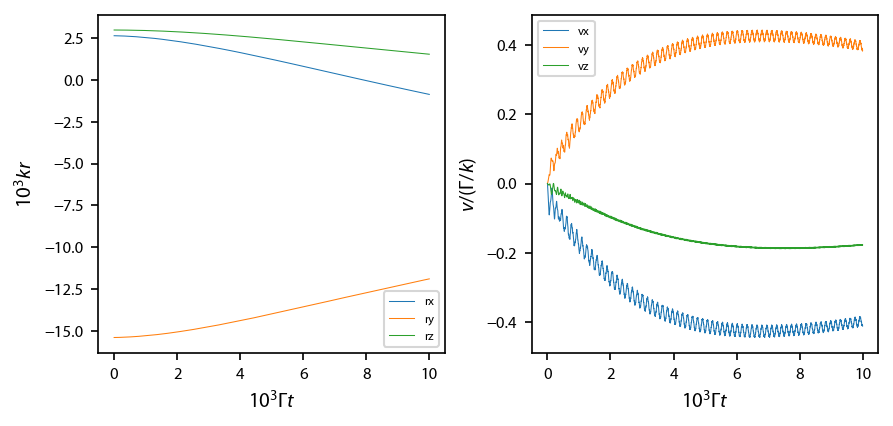
Evolution with random scattering¶
First run another test simulation:
[24]:
# %% Now try to evolve some initial state!
obe.v0 = 0.1*np.random.randn(3)
obe.r0 = 0.1*np.random.randn(3)/alpha
obe.set_initial_rho_from_rateeq()
# obe.set_initial_rho_equally()
t_span = [0, 5e4]
obe.evolve_motion(t_span,
progress_bar=True,
random_recoil=True
);
Completed in 5:40.
Plot it up:
[25]:
fig, ax = plt.subplots(1, 2, num='Optical Molasses F=0->F1', figsize=(6.5, 2.75))
ax[0].plot(obe.sol.t/1e3, obe.sol.r[0]/1e3,
label='$x$', linewidth=0.5)
ax[0].plot(obe.sol.t/1e3, obe.sol.r[1]/1e3,
label='$y$', linewidth=0.5)
ax[0].plot(obe.sol.t/1e3, obe.sol.r[2]/1e3,
label='$z$', linewidth=0.5)
ax[0].legend(fontsize=8)
ax[0].set_xlabel('$10^3 \Gamma t$')
ax[0].set_ylabel('$10^3 kr$')
ax[1].plot(obe.sol.t/1e3, obe.sol.v[0],
label='vx', linewidth=0.5)
ax[1].plot(obe.sol.t/1e3, obe.sol.v[1],
label='vy', linewidth=0.5)
ax[1].plot(obe.sol.t/1e3, obe.sol.v[2],
label='vz', linewidth=0.5)
ax[1].set_xlabel('$10^3 \Gamma t$')
ax[1].set_ylabel('$v/(\Gamma/k)$')
fig.subplots_adjust(wspace=0.25)
/Users/steve/opt/anaconda3/lib/python3.7/site-packages/IPython/core/pylabtools.py:132: UserWarning: Creating legend with loc="best" can be slow with large amounts of data.
fig.canvas.print_figure(bytes_io, **kw)
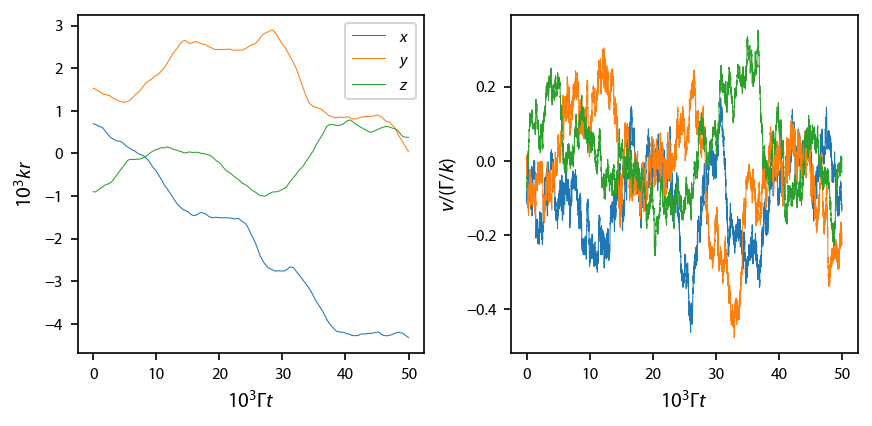
Now run 96 atoms. Again, we parallelize using pathos:
[12]:
import pathos
if hasattr(obe, 'sol'):
del obe.sol
tmax = 1e5
args = ([0, tmax], )
kwargs = {'t_eval':np.linspace(0, tmax, 5001),
'random_recoil':True,
'progress_bar':False,
'max_scatter_probability':0.5,
'record_force':False}
rscale = np.array([2, 2, 2])/alpha
roffset = np.array([0.0, 0.0, 0.0])
vscale = np.array([0.1, 0.1, 0.1])
voffset = np.array([0.0, 0.0, 0.0])
def generate_random_solution(x, tmax=1e5):
# We need to generate random numbers to prevent solutions from being seeded
# with the same random number.
np.random.rand(256*x)
obe.set_initial_position(rscale*np.random.randn(3) + roffset)
obe.set_initial_velocity(vscale*np.random.randn(3) + voffset)
obe.set_initial_rho_from_rateeq()
obe.evolve_motion(*args, **kwargs)
return obe.sol
Natoms = 96
chunksize = 4
sols = []
progress = progressBar()
for jj in range(int(Natoms/chunksize)):
with pathos.pools.ProcessPool(nodes=4) as pool:
sols += pool.map(generate_random_solution, range(chunksize))
progress.update((jj+1)/int(Natoms/chunksize))
Completed in 4:23:31.
Here’s another potential way to parallelize. We export a file that contains all the relevant data, and then execute the script run_single_sim.py. That grabs the data from the pickled file, and executes the sim 12 times and dumps the results into pickled files.
import dill, os
if hasattr(obe, 'sol'):
del obe.sol
tmax = 1e5
args = ([0, tmax], )
kwargs = {'t_eval':np.linspace(0, tmax, 5001),
'random_recoil':True,
'recoil_velocity':0.01,
'progress_bar':True,
'max_scatter_probability':0.5,
'record_force':False}
rscale = np.array([2, 2, 2])/alpha
roffset = np.array([0.0, 0.0, 0.0])
vscale = np.array([0.1, 0.1, 0.1])
voffset = np.array([0.0, 0.0, 0.0])
with open('parameters.pkl', 'wb') as output:
dill.dump(obe, output)
dill.dump(args, output)
dill.dump(kwargs, output)
dill.dump((rscale, roffset, vscale, voffset), output)
This code reads the pickled files:
files = os.listdir(path='./sims/')
sols = []
for file in files:
if file.endswith('.pkl'):
with open('sims/'+ file, 'rb') as input:
sols.append(dill.load(input))
print(len(sols))
No matter which way it was parallelized, let’s plot up the result:
[13]:
fig, ax = plt.subplots(3, 2, figsize=(6.25, 2*2.75))
for sol in sols:
for ii in range(3):
ax[ii, 0].plot(sol.t/1e3, sol.v[ii], linewidth=0.25)
ax[ii, 1].plot(sol.t/1e3, sol.r[ii]*alpha, linewidth=0.25)
"""for ax_i in ax[:, 0]:
ax_i.set_ylim((-0.75, 0.75))
for ax_i in ax[:, 1]:
ax_i.set_ylim((-4., 4.))"""
for ax_i in ax[-1, :]:
ax_i.set_xlabel('$10^3 \Gamma t$')
for jj in range(2):
for ax_i in ax[jj, :]:
ax_i.set_xticklabels('')
for ax_i, lbl in zip(ax[:, 0], ['x','y','z']):
ax_i.set_ylabel('$v_' + lbl + '/(\Gamma/k)$')
for ax_i, lbl in zip(ax[:, 1], ['x','y','z']):
ax_i.set_ylabel('$\\alpha ' + lbl + '$')
fig.subplots_adjust(left=0.1, bottom=0.08, wspace=0.22)
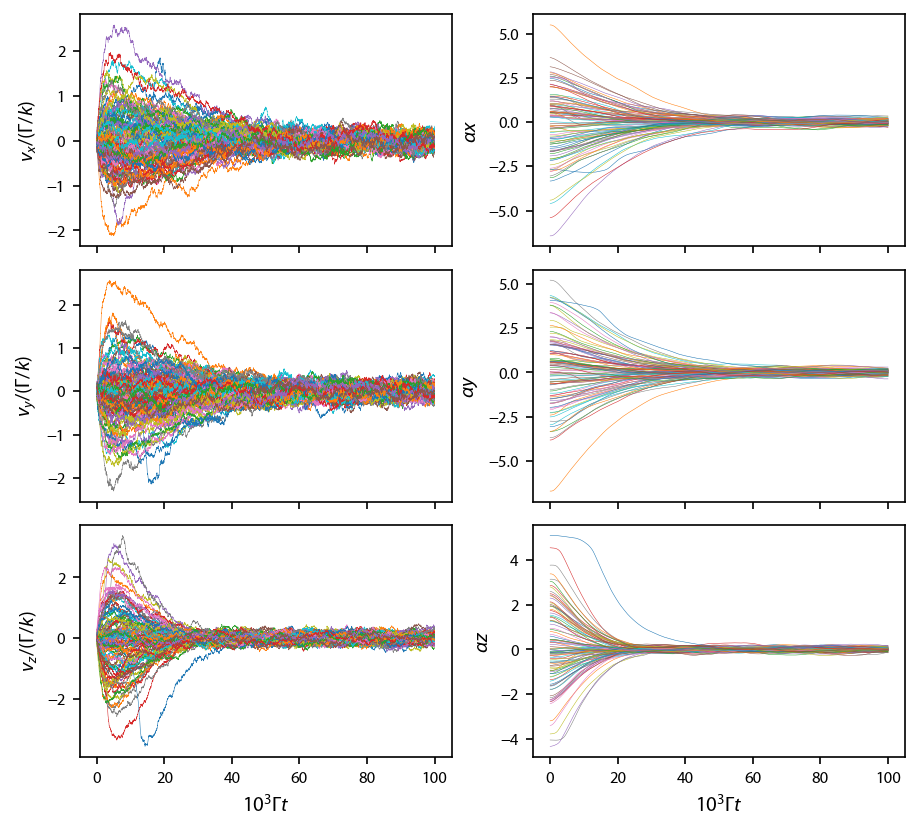
Reconstruct the force:
[14]:
for sol in sols:
sol.F, sol.f_laser, sol.f_laser_q, sol.f_mag = obe.force(sol.r, sol.t, sol.rho, return_details=True)
Concatenate all the positions and velocities and forces:
[15]:
allr = np.concatenate([sol.r[:, 500:].T for sol in sols]).T
allv = np.concatenate([sol.v[:, 500:].T for sol in sols]).T
allF = np.concatenate([sol.F[:, 500:].T for sol in sols]).T
Try to simulate what an image might look like (but we have to make it far more grainy because we have far fewer atoms):
[19]:
k = np.pi/2/780E-6
img, y_edges, z_edges = np.histogram2d(allr[1, ::100]/k, allr[2, ::100]/k, bins=[np.arange(-5., 5.01, 0.15), np.arange(-5., 5.01, 0.15)])
fig, ax = plt.subplots(1, 1)
im = ax.imshow(img.T, origin='bottom',
extent=(np.amin(y_edges), np.amax(y_edges),
np.amin(z_edges), np.amax(z_edges)),
cmap='Blues',
aspect='equal')
ax.set_xlabel('$y$ (mm)')
ax.set_ylabel('$z$ (mm)');
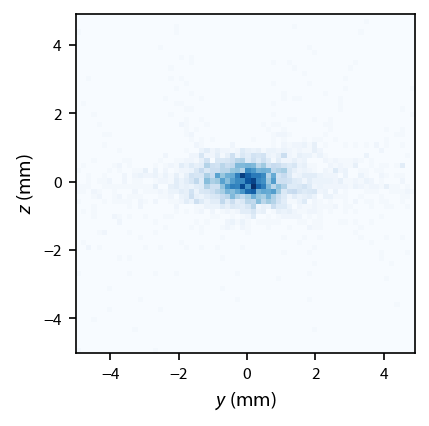
Let’s evaluate the temperature as a function of time:
[20]:
t_eval = kwargs['t_eval']
vs = np.nan*np.zeros((len(sols), 3, len(t_eval)))
for v, sol in zip(vs, sols):
v[:, :sol.v.shape[1]] = sol.v
sigma_v = np.nanstd(vs, axis=0)
sigma_v.shape
fig, ax = plt.subplots(1, 1)
ax.plot(t_eval*1e-6, 2*sigma_v.T**2*hamiltonian.mass)
ax.axhline(1, color='k', linestyle='--')
ax.set_ylabel('$T/T_D$')
ax.set_xlabel('$10^6 \Gamma t$');
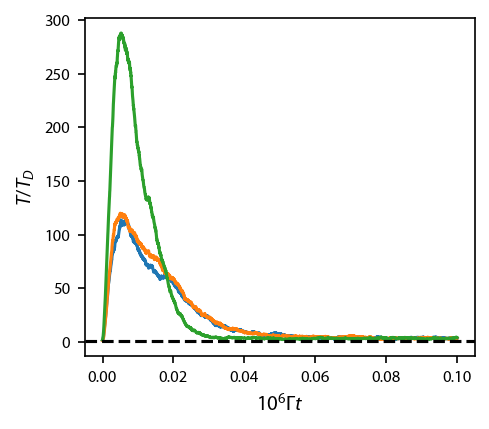
[21]:
# Make a bunch of bins:
xb = np.arange(-0.5, 0.5001, 0.05)
lbls = ['x', 'y', 'z']
fig, ax = plt.subplots(1, 3, figsize=(6.5, 2.75))
for ii, lbl in enumerate(lbls):
# Make the histogram:
ax[ii].hist(vs[:, ii, 2500::500].flatten(), bins=xb)
# Extract the data:
x = xb[:-1] + np.diff(xb)/2
y = np.histogram(vs[:, ii, 2500::500].flatten(), bins=xb)[0]
# Fit it:
model = lmfit.models.GaussianModel()
result = model.fit(y, x=x)
# Plot up the fit:
x_fit = np.linspace(-0.5, 0.5, 101)
ax[ii].plot(x_fit, result.eval(x=x_fit))
ax[ii].set_xlabel('$v_%s/(\Gamma/k)$'%lbl)
# Add the temperature
plt.text(0.03, 0.9,
'$T_%s/T_D = %.1f$'%(lbl, 2*result.best_values['sigma']**2*hamiltonian.mass),
transform=ax[ii].transAxes)
fig.subplots_adjust(left=0.07, wspace=0.15)
